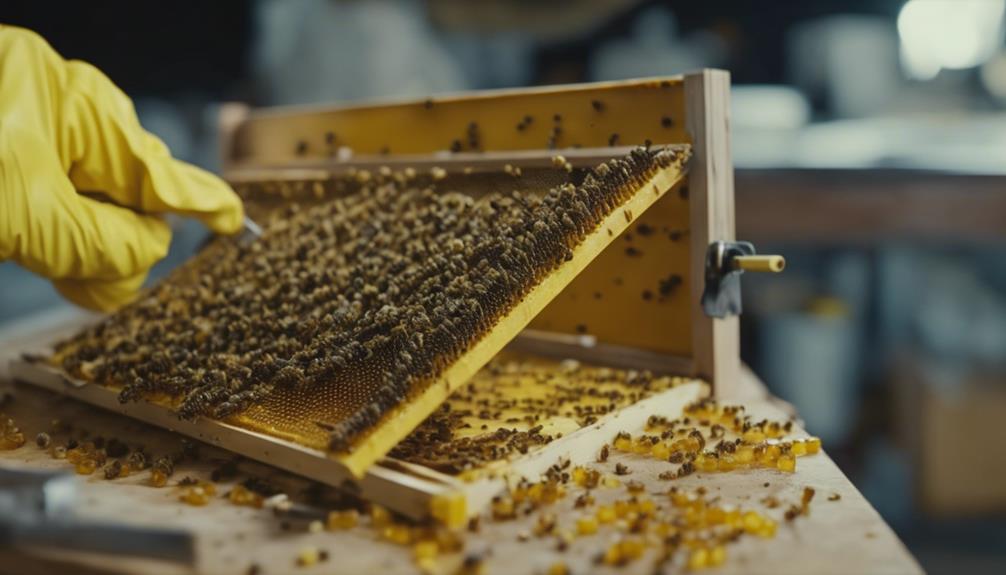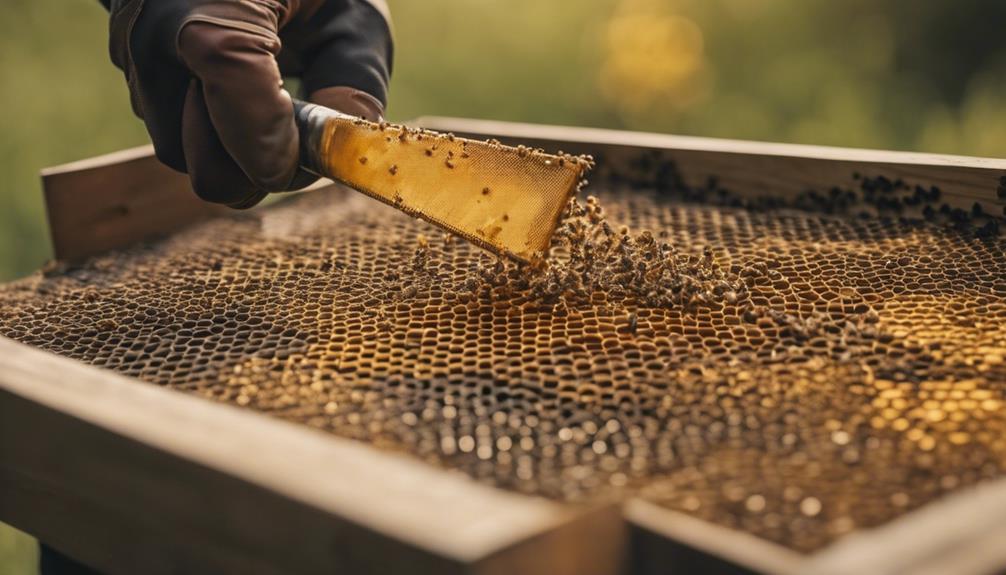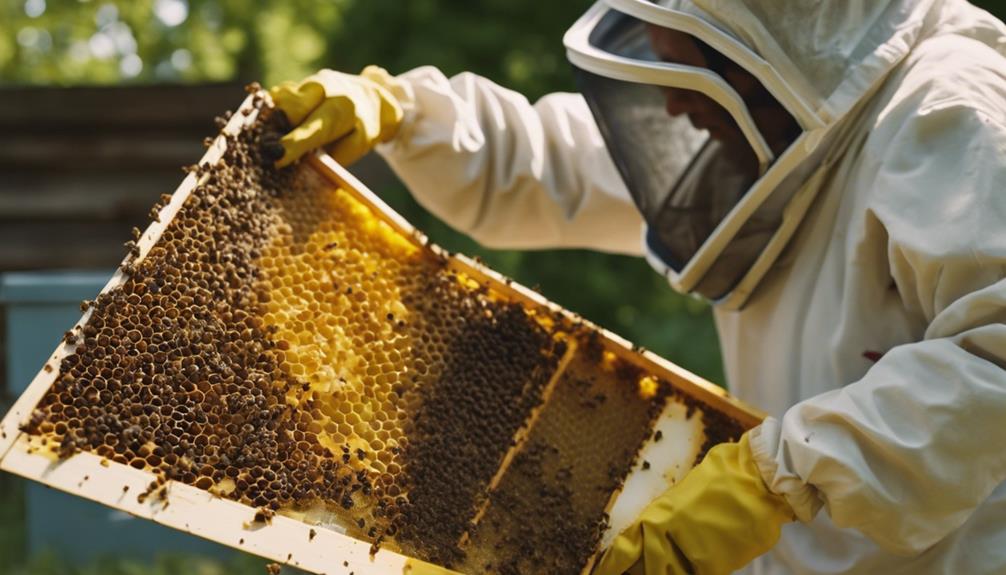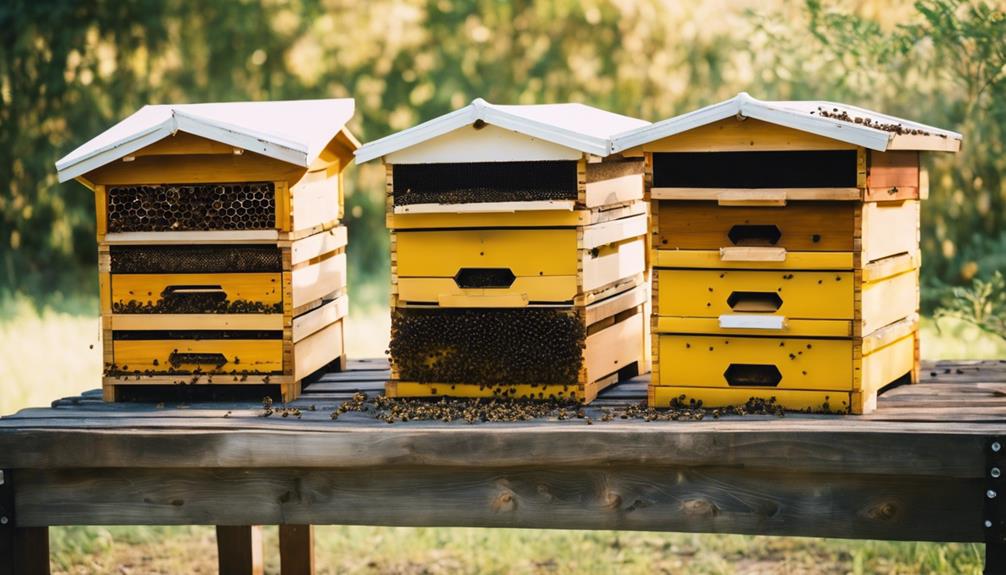A hive tool is a essential in beekeeping, helping us manage hives safely and efficiently. It’s like the beekeeper’s reliable sidekick, assisting in hive inspections, frame manipulation, and overall hive maintenance. With its flat blade for prying and a curved end for lifting frames, this tool is a game-changer in the beekeeping world. Plus, it’s our go-to for avoiding unnecessary hive damage and bee stings. If you want a peek into the hive tool’s full potential, keep exploring the ways it enhances the beekeeping experience.
Main Points
- Safely opens beehives during inspections.
- Assists in smooth hive management tasks.
- Prevents damage to hive components.
- Safely removes bee stingers.
- Essential for efficient hive maintenance.
Importance of a Hive Tool
Visualize this: you’re out in the field, the sun shining, bees buzzing, and with a simple flick of the wrist using your trusted hive tool, you’re diving into the hive like a pro. Dadant & Sons Beekeeping Supplies knows their stuff when it comes to crafting these tools, making our beekeeping experience smoother and more enjoyable.
Whether you’re a seasoned pro or just starting out, a high-quality hive tool is a must-have in your beekeeping arsenal. This tool is like the Swiss Army knife of beekeeping, helping us crack open those hives with ease.
It’s moments like these that remind us of the magic of beekeeping.
Hive Tool Components
Hive tools are comprised of a flat, chisel-like blade for prying and scraping, along with a curved, hook-like end for lifting frames and hive components. When beekeeping, these components are essential for efficient hive management and maintenance. Here are the key components of a hive tool:
- Flat Blade: The flat blade of a hive tool is perfect for gently prying apart hive components like boxes or frames without causing damage.
- Curved End: With its hook-like curve, this end of the tool is designed to lift frames with ease, allowing beekeepers to inspect their colonies effectively.
- Multi-functional Design: The combination of the flat blade and curved end makes the hive tool versatile, enabling beekeepers to scrape off propolis and burr comb while also aiding in hive inspections.
Functions of a Hive Tool

In terms of the functions of a hive tool, we need to grasp the fundamentals, purposes, and upkeep.
Hive tools are crucial for safely opening beehives, moving heavy frames, scraping off propolis, and more.
Let’s delve into how these tools make beekeeping tasks more manageable and efficient.
Hive Tool Basics
For beekeepers, a hive tool serves as an indispensable instrument for safely managing beehives and conducting routine inspections. Here are some essential functions of a hive tool:
- Open the Hive: The primary purpose of a hive tool is to help beekeepers easily open beehives without causing any harm to the bees or the hive structure.
- Inspect and Maintain: This versatile tool assists in inspecting hives, lifting and shifting frames, as well as scraping off excess wax and propolis, ensuring the hive components are well maintained.
- Prevent Damage: By using a hive tool correctly, beekeepers can prevent damage to the hive during inspections, enhancing the overall beekeeping experience and promoting hive health and productivity.
Hive Tool Uses
With its multifunctional design, a hive tool proves indispensable in various beekeeping tasks, ensuring the smooth and efficient management of beehives. This handy tool assists in opening beehives and separating hive components safely and efficiently.
The hook-like end allows for lifting frames without harming the bees, while the serrated edge is perfect for scraping off propolis, burr comb, or debris from hive surfaces. Additionally, it comes in handy for removing the lid of a bee package or dislodging bee stingers from the skin.
In essence, the hive tool is like a trusty sidekick to a beekeeper, aiding in essential hive maintenance tasks and other beekeeping operations with ease. It’s truly a must-have for anyone tending to bees.
Hive Tool Maintenance
Sticky residues like honey, propolis, and wax accumulate on hive tools during beekeeping activities, necessitating regular cleaning for maintenance. Here’s how we keep our hive tools in top shape:
- Clean with Water: A good rinse with water helps remove the initial layer of stickiness.
- Use Comet with Bleach Powder: For tougher residue, a scrub with this powerful cleaner works wonders.
- Sanitize with Rubbing Alcohol: After cleaning, a quick wipe with rubbing alcohol helps prevent the spread of bee diseases.
Hive Tool Versatility

When we ponder hive tools, it’s intriguing to contemplate their versatility. From prying apart hive components to aiding with inspection and maintenance, these tools are like the Swiss Army knife of beekeeping.
Whether it’s scraping off propolis or safely removing bee stingers, hive tools truly demonstrate their worth in various beekeeping tasks.
Hive Tool Functions
The hive tool serves various essential functions in beekeeping operations, enhancing efficiency and safety during hive management tasks. Here are some key functions of the hive tool:
- Opening the Hive Safely: This tool allows beekeepers to access the hive without causing damage, making it easier to check on the bees and their progress.
- Inspecting Frames: By loosening and lifting frames, beekeepers can inspect the hive for signs of disease, pests, or the overall health of the colony.
- Maintaining Hive Cleanliness: Scraping off excess propolis and burr comb helps keep the hive clean and organized, promoting a healthier environment for the bees.
These functions demonstrate the versatility of the hive tool, making it a must-have for any beekeeper looking to efficiently manage their hives.
Hive Tool Maintenance
Regular maintenance of hive tools is vital to guarantee their longevity and peak performance in beekeeping activities. To keep your hive tools in top shape, proper cleaning is key. Using water, Comet with Bleach powder, and a scrubber effectively removes honey, propolis, and wax residues.
Remember to sanitize the tools with rubbing alcohol after cleaning to prevent the spread of bee diseases. Tough residues can be tackled with Comet with Bleach powder and a stainless steel scrubber.
Additionally, asking visitors to use your hive tools can help prevent diseases from spreading between hives. By incorporating these maintenance practices into your beekeeping routine, you ensure that your hive tools remain reliable companions in your beekeeping adventures.
Using a Hive Tool Safely
How can we guarantee the safe use of a hive tool when working with bees? It’s essential to prioritize safety to make sure a smooth beekeeping experience. Here are some key tips to help us use a hive tool safely:
- Wear Protective Gear: Don’t forget your gloves and veil to shield yourself from bee stings.
- Approach Calmly: Avoid sudden movements near the hive to prevent agitating the bees.
- Handle with Care: Use the hive tool precisely to avoid damaging hive components or harming the bees.
Hive Tool Maintenance Tips

To maintain hive tools effectively, prioritize regular cleaning to remove sticky residues like honey, propolis, and wax. Cleaning hive tools with water, Comet with Bleach powder, and a scrubber helps get rid of debris that can build up over time.
Remember, proper maintenance is key to ensuring the longevity and efficiency of your hive tool. After cleaning, it’s a good idea to sanitize the tools with rubbing alcohol to prevent the potential spread of bee diseases.
Visitors should always use your hive tools to avoid transferring any harmful pathogens between hives. By following these simple maintenance tips, you can keep your hive tools in top condition, ready to assist you in your beekeeping endeavors.
Types of Hive Tools
In terms of beekeeping tools, comprehending the different types of hive tools available can significantly enhance efficiency and ease during hive inspections and maintenance tasks. Here are a few essential hive tools to contemplate:
- Standard Hive Tool: This tool features a flat, chisel-like blade perfect for prying apart hive components and a curved, hook-like end for efficiently scraping and lifting frames.
- J-Hook Hive Tool: Resembling the shape of the letter J, this tool is excellent for effortlessly lifting frames during inspections, making the task smoother and less strenuous.
- Frame Lifter Hive Tool: Specifically designed for securely lifting frames within the hive, this tool ensures that frames can be handled safely and with precision.
Choosing the Right Hive Tool

When selecting the appropriate hive tool for beekeeping tasks, consider the shape and size variations that best suit your specific needs and preferences. Hive tools come in different types, each catering to various aspects of hive management. Whether you opt for a flat blade, a bent-over blade, or hooks, the choice depends on what works best for you.
Size matters too, as different tasks may require different lengths or widths to handle efficiently. It’s crucial to pick a style that aligns with your beekeeping activities to guarantee maximum effectiveness. Also, having a spare hive tool is handy since these tools have a knack for disappearing during the hustle of beekeeping.
Evaluate the blade slope as well to ensure ease of use and smooth hive manipulations.
Hive Tool Best Practices
Considering the various types of hive tools available, mastering proper handling techniques guarantees efficient hive management and minimal disturbance to bee colonies. When using hive tools, it’s essential to follow these best practices:
- Choose the Right Tool: Select the best hive tool for the task at hand, whether it’s a standard, J-hook, frame grip, or multi-functional tool.
- Maintain Your Tools: Regularly clean and inspect your hive tools to prevent the spread of bee diseases and ensure their effectiveness over time.
- Handle with Care: Use gentle and precise movements when using your hive tool to avoid unnecessary disruption to the bees and their home.

Roger Thomas is a seasoned beekeeper and hive architect with a deep-seated passion for sustainable living. His fascination with bees has shaped his professional career, giving him practical and theoretical expertise in bee behavior, colony health, and optimal hive conditions. Roger’s technical skills shine in his bespoke hive creations that cater to the specific needs of diverse bee species, while his sustainable practices promote environmental balance and the wellbeing of the bee population.
As he continues his journey in beekeeping, Roger has become a dedicated advocate for responsible practices and an insightful educator in his field. His posts aim to inspire new beekeepers, underline the importance of sustainability, and showcase the remarkable contribution bees make to our ecosystem. Roger invites you to join him as he delves into the world of bees and the rewarding, honey-sweet art of beekeeping.


